NEW: Nature Regional Landscape Parks – Where Policy meets Pratice
EUROPARC’s new position paper, launched at the Real “Green” Deal workshop on 22 October 2020, highlights the importance of Nature Regional Landscape Parks.
Nature Regional Landscape Parks – Where policy meets practice
Nature Regional Landscape (NRL) Parks are strong partners to address the Green Deal challenges at a local level, working on the implementation issues of Biodiversity Strategy 2030, 2030 Climate Target Plan, Farm to Fork Strategy and CAP and Forestry Strategy, as well as policies associated with health, sustainable tourism, culture and environmental education. However, these park remain an undervalued resource, to create “Living Landscapes“, that are good for nature and good for people.
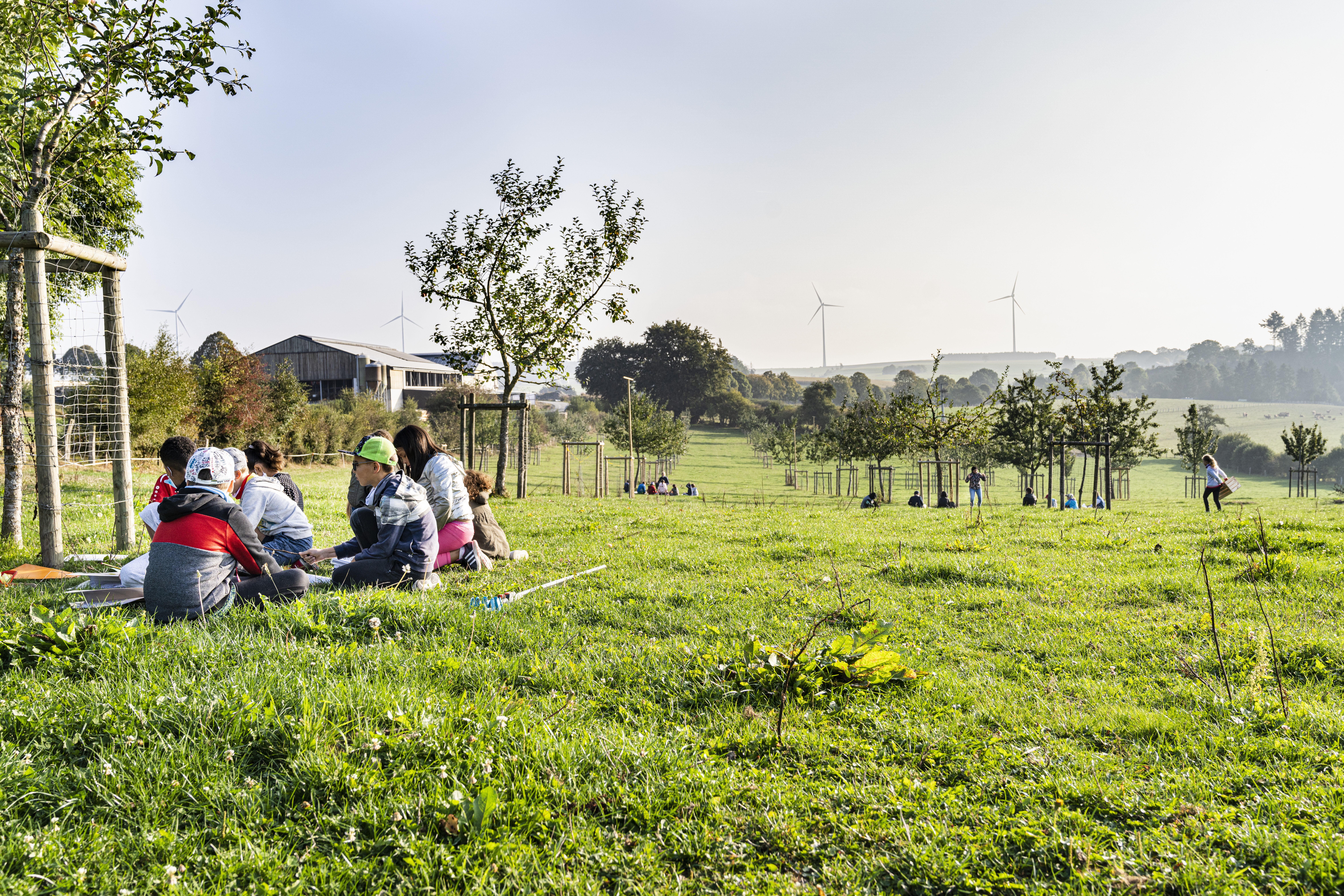
Naturpark Our, photo: Caroline Martin.
NRL Parks have the potential to prevent current rural abandonment, promote community involvement and support green jobs. They create sustainable tourism destinations, and encourage sustainable agricultural practices and partnerships between farmers and protected areas management. Additionally, they are excellent places for environmental education. Today, EUROPARC launched the new policy paper ” Nature Regional Landscape Parks – Where Policy meets Practice”.
The policy paper shows that it pays off to strengthen the position of NRL Parks because they can help ensure a better implementation of far-sighted approaches for a sustainable rural Europe.
The paper collates NRL Parks experience from across Europe, and indicates the policy framework that they implement. It shows the potential locked in these parks to deliver more.
Download the Policy Paper here!
The Real “Green” Deal workshop
The position paper was launched at the workshop The Real “Green” Deal, which was organised in the framework of the 18th European Week of Cities and Regions. The online workshop focused on the vital role of Regional Natural Parks in a sustainably managed Green Europe. It was moderated by EUROPARC Executive Director Carol Ritchie. She was joined by the following speakers:
- Eric Brua, Director, Natural régional Parks french fédération, France.
- Katy Foxford, Tourism Support Officer, Yorkshire Dales National Park Authority, United Kingdom.
- Stefan Müller-Altermatt, President of the Swiss Parks Network and Member of Parliament, Swiss Parks Network, Switzerland.
- Nina Zitz, Project coordinator, Association of Austrian Nature Parks, Austria.
The speakers from all over Europe presented different aspects related to Regional Nature Parks, such as climate change protection, ecological infrastructure for biodiversity, sustainable agriculture and youth empowerment.
National Regional Landscape Parks are ideal testing grounds for agricultural practices that play an active role in the preservation of natural areas
Said Eric Brua during his presentation on sustainable agricultural practices in NRL Parks. Sustainable agriculture is a topic that is especially present at this time, as the European Parliament will vote on the new CAP this week. In his presentation he demonstrated the great work the Nature Regional Parks in France or doing with farmers to establish sustainable agricultural practices.
Nina Zitz presented the work of Austrian Nature Parks on climate change adaption and mitigation. The presentation of projects like “Wöffies“, “Climate Walk” and “KlimaAlps“, showed what Austrian Nature Parks are doing to both combat climate change and raise awareness on the topic. The aim is to develop a common climate strategy for nature parks.
Stefan Müller-Altermatt showed how the Swiss Nature Parks make a significant contribution to ecological infrastructure. Not just by preserving, creating and maintaining core areas, but also by remedying deficits. The latter is done in cooperation with agriculture and forestry. Additionally he said that contrary to popular believe, lack of biodiversity in Swiss, especially in the densely populated lowlands is a problem. The Swiss Nature Parks work on combating this biodiversity loss, for example by bringing sheep from Engadin to the Beverin Nature Park.
Katy Foxford then gave examples of how the Youth Manifesto can help keep rural areas alive, by involving young people in decision making processes and attracting them to rural areas through job opportunities or affordable housing. She highlighted the importance of including young people in the implementation of policies like the EU Green Deal.
Through Mentimeter, Carol Ritchie asked participants what they think “regions” need to do, to ensure the potential of NRL Parks to deliver the Green Deal. You can see the results here:
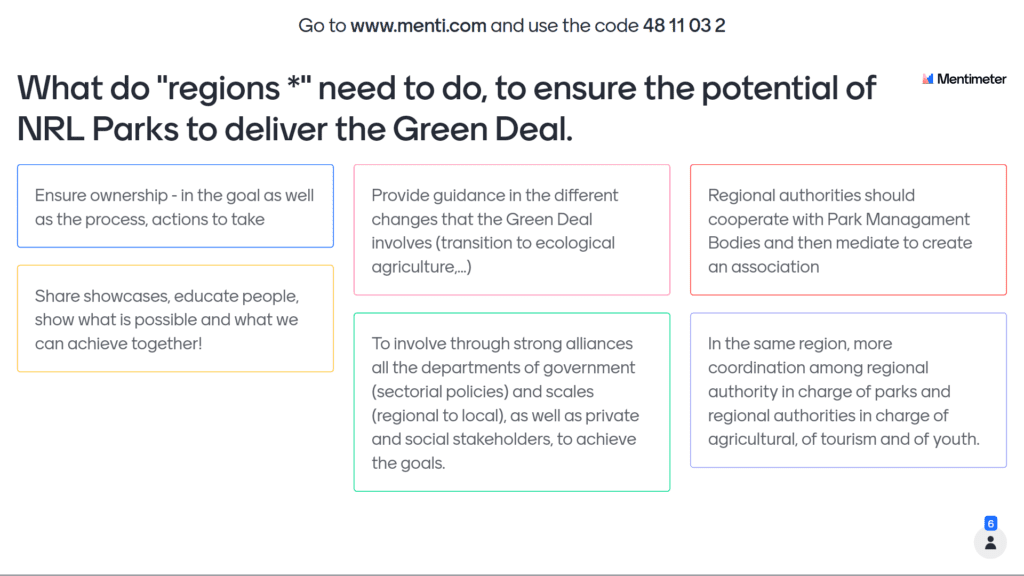
National Regional Landscape Parks are natural allies to develop sustainable agriculture business in rural areas and to make people stay and work in rural areas – particularly for young people
Said Roby Biwer, member of the European Committee of Regions. He closed the webinar and highlighted that, National Regional Landscape parks also have a role to play in Farm to Fork, Sustainable Development Goals and the Biodiversity Strategy – they can be accelerators to make these policies more central at regional, national and European level.
If you could not attend the workshop, a recording will be made available here.
Download the PowerPoint presentations here:
Nina Zitz – Association of Austrian Nature Parks
Stefan Müller-Altermatt – Swiss Parks Network
Katy Foxford – Yorkshire Dales Natioanl Park Authority
Eric Brua – Natural Regional Parks Federation France
Download the Policy Paper here!
Call to action
In order to fully utilize the opportunities of Nature Regional Landscape Parks in implementing an integrated, visionary approach for a sustainable rural Europe, EUROPARC calls upon the European Union and its Member States , local and regional authorities to be actively involved in the work of Nature Regional Landscape Parks with protection, valorisation and sustainable development of the natural and cultural heritage of their territories. EUROPARC Federation also seeks that EU institutions, better integrate Nature Regional Landscape Parks in EU policies, recognising their implementation role, to give them the support and access to tools and funding required to carry out efficiently all actions needed. Europe’s Nature Regional Landscape Parks are the “real” Green Deal, with the potential to be the catalyst of local solutions that will bring about the changes needed to create a more sustainable Europe
What are Nature Regional Landscape Parks?
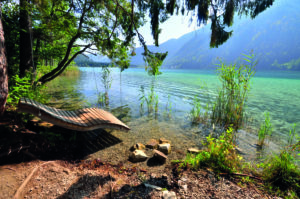
Nature Park Weissensee, by Ewald Neffe
The term, Regional Nature Landscape Parks contains a wide variety of large scale Protected Areas across Europe. These include, Nature Park, Natural Park, Regional Park, Landscape Park, Regional Nature Park, Protected Landscape Area or Area of Outstanding Natural Beauty.
Overall, NRL Parks have been designated, with the aim to integrate the protection of biodiversity with sustainable land use and socio-economic development in their territories.
Currently, there are almost 900 Regional Nature Landscape Parks in 22 European countries, which is about 8 % of the European Union (+ Norway and Switzerland). Although they differ across countries, they share common principles in terms of purpose, mission and governance. They are important players when it comes to rural development, sustainable agriculture, biodiversity protection and nature education (among others).
Head over to our knowledge hub and read case studies from Nature Regional Landscape Parks in our Knowledge Hub!
How can we communicate to, with and for farmers: Workshop outcomes
© Agriculture_European Commission
EUROPARC’s Online Conference 2020 included 8 thematic workshops on diverse topics related to practice and capacity building in Protected Areas. In case you have not attended, or want to remind yourself of their outcomes, a series of articles summarises the content of some of these workshops.
From European level, to field experience
In the workshop presentations, insights from two different levels were discussed. First, Stefania Petrosillo, EUROPARC Policy Officer in Brussels, shared the relevant EU Policies that were focused on agriculture and Protected Areas. These included the Green Deal, the Farm to Fork Strategy and the Common Agriculture Policy. There is both a challenge in the increasing pressures on agriculture and an opportunity in the increasing attention for the environment.
Baptiste Hottekiet, Director of the Pays des Collines Nature Park and Representative of the Federation of Nature Parks of Wallonie-Belgium was the second presenter. He explained how Protected Areas can facilitate communication with farmers. This can lead to cooperation that is beneficial for both the Protected Areas and the farmers. For example, the farmer image towards consumers can improve substantially.
Since we accompany farmers in their work for a better sustainable and profitable agriculture, we have each year more and more farmers who participate to our nature’s projects. It’s a long-term process but it works.
The ways Pays des Collines Nature Park communicated and cooperated with farmers varied greatly. Farmers were involved in decision making processes and farmers markets with local products and educational activities were organised.
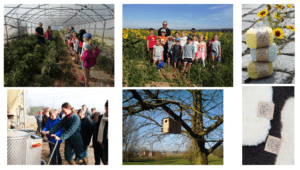
Presentation Slide – Baptiste Hottekiet
What is needed
So where do these insights leave us? In the presentations and discussions, it was evident that communication is key, both with farmers and at an EU level. By using the language of Farmers and understanding what they need, you can start a dialogue. This eventually leads to cooperation that is beneficial to both the farmer and the Protected Area.
Therefore, knowledge on how to communicate is needed in the case of farmers and the case of EU Policy. This can be provided through the creation of ‘tools’ for farmers and the exchange of knowledge between Protected Areas on this subject.
EUROPARC Federation can serve as a forum for capacity building, inspiration and sharing of best practices. By also keeping close contact with the EU institutions, Protected Areas will also stay well-represented in agricultural policies. Read for example the Position Paper on European Protected Areas and Sustainable agriculture.
For more information, please do not hesitate to contact Stefania Petrosillo, Policy Officer at EUROPARC Federation or to download the workshop presentations below.
Download the presentations:
- Case study: How Walloon Nature Parks promote a better communication with farmers?, by Baptiste Hottekiet (Director of NP Pays des Collines, BE) – download
- Presentation: The EU new strategies: Biodiversity 2030 and Farm To Fork, by Stefania Petrosillo (EUROPARC Policy Officer) – download
More info on sustainable agriculture: go here
Europe’s Biodiversity is under pressure
Parc naturel régional de Brière (FR) © Photo Jean Pierre Saliou
With the start of the EU Green week, the European Environmental Agency (EEA) has published its rapport “State of Nature in EU”.
The European Environmental Agency’s report “State of Nature in EU” is a comprehensive “health check” of nature in the European Union. It reports on the status and trends in 2013 -2018 of species and habitat types protected by the Birds and Habitats Directives. EU member states are required to report every six years to gauge the state of nature in the EU.
The results of the past 5 years show that nature is under pressure and that there is still a lot of work that needs to be done.
The report demonstrated a continuing decline of protected habitats and species. This is mostly caused by intensive agriculture, urbanization, unsustainable forestry activities and changes to freshwater habitats. Pollution of air, water and soil also impacts habitats, as well as climate change, over-exploitation of animals through illegal harvesting and untenable hunting and fishing. Additionally, member states are not prioritizing nature protection enough. So, as our president Ignace Schops said with the publication of the Global Biodiversity Outlook 5, it’s “high time to turn tide!“.
To make a lasting change, EEA Director Hans Bruyninckx says we need to drastically change the way we produce our food, manage our forests and build our cities. Additionally, we need to better execute nature protection, restoration and set more ambitious climate targets. EUROPARC knows that the answer lays within nature, and that protecting our valuable ecosystems is not only necessary, but also effective: improvement are recorded in bird populations in Natura 2000 areas.
Improvement of Natura 2000 areas
Although a decline is visible across almost all populations and habitats, some positive news can be found in the report as well. The amount and size of Natura 2000 areas has increased in the last six years, causing the EU to reach global targets. Currently 18% of the land and almost 10% of marine area is protected. However, we are still a long ways of the targets in the EU “Green Deal”, where the goals is to legally protect 30% of the land.
Time for action
The message is clear: if we continue along this path we will destroy valuable habitats and species. EUROPARC urges EU member states to priorities nature protection and restoration. We do not need more “paper parks”,
Europe needs well-managed Protected Areas as places where nature can thrive.
EUROPARC’s members are ready to be key players in reaching the EU targets on biodiversity, not just as “far away places”, but also in greening urban areas or by realizing sustainable agriculture practices. The European Commission wants to “bring nature back into our lives” – Europe’s Protected Areas, when supported politically and financially, are ready to deliver.
Want to find best practice examples of all that EUROPARC’s members are doing? Then have a look at our “Knowledge Hub“
Get to know the Natura 2000 Award winners!
The winners of the European Natura 2000 Award were announced at a livestreamed Ceremony on the 14th October 2020. Get to know the winners!
Natura 2000 Award Ceremony
This year, the Natura 2000 Awards reached its 5th edition, and after a thoughtful revision of the 79 eligible applications from 26 countries, 27 finalists were selected for the final round. Among them were several EUROPARC members, such as:
- German Association for Nature Protection (NABU) – Gransee with the project Diving for conservation;
- The Thuringian Ministry of Environment, Energy and Conservation leading the project Network of Natura 2000 stations in Thuringia;
- Cascais Ambiente with the project Quinta do Pisão Nature Park.
After an external evaluation of each application was carried out, a dedicated jury had the difficult task to decide which of the applicants, clustered in five different categories, were the winners of the European Natura 2000 Awards.
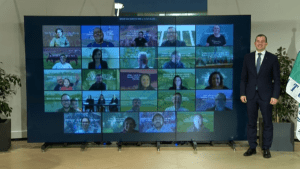
Some of the finalists of the N2000 Award
This year, and following the format of many of the events that took place since the start of the COVID 19 pandemic, the Natura 2000 Award Ceremony was hosted online. However, the Ceremony did not lack any of the ingredients that an Award Ceremony has: nerves and excitement from the side of the participants, which were present through their screens and presented one by one from by the moderator Suyin Aerts, and a friendly environment and enthusiasm jointly created by the European Commissioner for Environment, Oceans and Fisheries, Virginijus Sinkevičius, and the Jury members that announced each of the winners:
In the COMMUNICATION category, the Award went to:
Eau la la!!! Eco-tips for sea and shore! – France, implemented by Lannion-Trégor Communauté, Guingamp-Paimpol Agglomération and PETR du Pays de Guingamp.
In the SOCIO-ECONOMIC BENEFITS category, the Award went to:
Pro-Biodiversidad: Shepherds as biodiversity conservators in Natura 2000 – Spain, led by the Fundación para la Conservación del Quebrantahuesos with the collaboration of local farmers.
In the CONSERVATION category, the Award went to:
Using underwater inventories for the conservation of marine areas in Finland – Finland, led by the Ministry of the Environment and the Finnish Environment Institute (SYKE).
In the RECONCILING INTERESTS/ PERCEPTIONS category, the Award went to:
Ten keys to co-ownership for nature projects – Belgium, implemented in Belgium by the Agentschap voor Natuur en Bos, De Vlaamse Waterweg, Gemeente Kruibeke and vzw Kruibeeks Natuurbehoud.
In the CROSS-BORDER COOPERATION AND NETWORKING category, the Award went to:
Joint efforts for safe and wildlife-friendly transportation networks in the Carpathians – Czech Republic, led by the Nature Conservation Agency of the Czech Republic, with partners in Romania, Austria, Hungary, Czech Republic, Slovakia, and Ukraine.
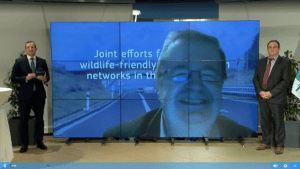
Representative from the Nature Conservation Agency of the Czech Republic receiving the Award
The leading institution, Nature Conservation Agency of the Czech Republic, is a EUROPARC member.
The project is based on a multidisciplinary cooperation through cross-border networking to share experiences and best practices, and stimulate discussion amongst all relevant sectors in order to improve and develop safe and environmentally-friendly road and rail transport solutions.
And finally, the European Citizen’s Award, which is granted based on a public voting that took place from June to September 2020, was announced. For this award, a total of almost 45,000 votes were casted among all the finalists, regardless of the category they were included in. As a result, the prestigious
EUROPEAN CITIZEN’S AWARD went to:
Partnership for protection of Bulgarian old-growth forests in Natura 2000 – Bulgaria, led by the Executive Forest Agency (EFA), the Ministry of Agriculture, Food and Forestry, Bulgaria, WWF Bulgaria, the Association of Parks in Bulgaria and the Balkani Wildlife Society. This project helped to reconcile conflicting interests over the designation of forest-related Natura 2000 sites.
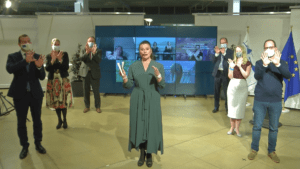
The winners of the Natura 2000 Award
About the Natura 2000 Awards
The Natura 2000 Awards was first launched in 2014 in order to recognise successful stories of conservation across the EU and raise awareness about one of Europe’s outstanding achievements – the Natura 2000 network of protected areas.
